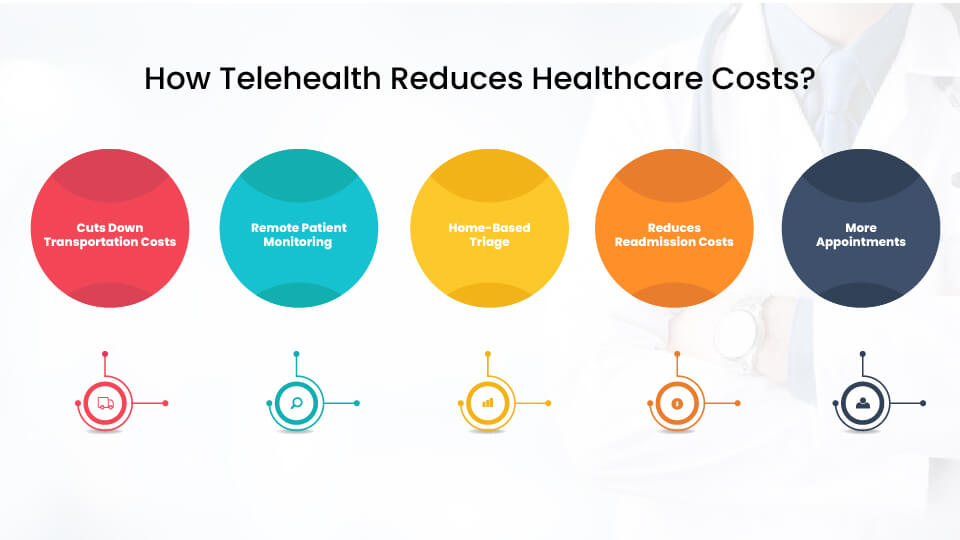Using Telemedicine to Reduce the Cost of Healthcare
Ditstek Blogs
The pandemic pushed Telemedicine to the forefront, and since then it has been witnessing a constant surge. A study by Global Market Insights Inc says that the telemedicine market is set to reach up to $130 billion by 2025. Not only does telemedicine allow healthcare professionals to evaluate, diagnose or treat patients virtually, but healthcare providers have also reported significant savings after embracing the technology. Still, many healthcare leaders fail to realize the positive impact of telemedicine on an organization’s bottom line by cutting down costs and reducing losses.
In this blog, we’ll explore how telemedicine can reduce healthcare costs, and how DITS - a custom healthcare software development company, can help you build innovative telemedicine & telehealth solutions.
How Does Telemedicine Help?

Telemedicine was once used for sending medical images, like X-rays, paving the way for the industry. However, telemedicine today is more than that. With constant technological advancements, remote analytical services, like Teleradiology, Tele-Emergency, Tele-ICU, etc. allow resource pooling while reducing cost and improving the quality of care.
Unlike earlier when in-patient monitoring was the only viable option, remote monitoring makes it possible to monitor patients on an ambulatory basis. This translates to significant savings for healthcare providers. When patients’ vitals are monitored remotely, it allows for more active and quick healthcare interventions by reducing the chances of clinical emergencies.
Telemedicine is a boon for mental and behavioral healthcare too. With telemedicine, patients can easily find doctors for their specific health issues within minutes and receive the care they need. In addition, telemedicine apps allow patients to schedule appointments or consult a physician without having to visit the hospital or clinic. In a nutshell, telemedicine saves time, lowers medical costs, reduces travel expenses, and improves healthcare outcomes.
How Telehealth Reduces Healthcare Costs?

Here are some important ways telemedicine can play a crucial role in reducing overall healthcare spending-
Cuts Down Transportation Costs
Travel or transportation costs are not just about patients. This also includes how much the doctor’s visit costs to the healthcare provider. By using telemedicine & telehealth apps, it becomes easy to prioritize and optimize emergency health cases, cut down clinician travel costs, and avoid unnecessary visits. Likewise, telehealth makes life easier by eliminating the need to visit the doctor’s office for minor queries, thereby saving a lot of money.
Remote Patient Monitoring
Whether a patient has just been discharged from the hospital or the patient has an implanted device that needs to be monitored, remote patient monitoring allows the care staff to keep track of their conditions frequently. Also, not all these practices are to be done in the clinic. Telehealth allows providers to monitor their patients’ health online, thus reducing healthcare costs.
Home-Based Triage
In cases where clinician visits are not necessary, televisits with nurses or primary care staff can deliver important consultations. If a patient is in a critical condition, remote appointments can speed up ambulance visits and allow physicians to take proactive steps to manage the patient’s health conditions.
Reduces Readmission Costs
Regular check-ups after getting discharged from the hospital can help keep patients healthy and reduce their chances of returning. Some check-ups don't need to be done in person and can be done over the phone or through video calls. With telemedicine/telehealth solutions, it is easier for patients to get the care they need and improve their health outcomes.
More Appointments
In most cases, the number of appointments a healthcare provider can offer depends on how many patients they can see at once. But not every appointment needs tests right away—sometimes patients just need to talk to a doctor. Telemedicine can help providers see more patients for initial appointments, and using EHRs can make it easier for doctors to manage paperwork and appointments.
General Benefits of Integrating Telehealth Into Your Practice
Helps Decrease Recruitment Costs
Considering the factors, like higher salary, the time-consuming interview process, and the monetary losses while a specific position was not filled, replacing a medical staff member can be costly. Fortunately, health tech advancements, like Telemedicine offer more flexibility, convenience, and productivity to the staff. It is like an escape route for healthcare professionals who are otherwise bound to their strict schedules. This way, telemedicine helps the medical staff to combat burnout and gives them much-needed time back. The result is reduced recruitment costs and less turnover.
Helps Decrease New Patient Acquisition Costs
Winning new patients has never been more cost-effective than now! Not to mention, customers are the lifeblood of any business, and healthcare is no exception. However, in order to offset any potential losses, many healthcare providers stick to only a few profitable healthcare services. It is imperative that healthcare organizations establish themselves as the ones that acknowledge modern customers’ expectations with respect to convenience and quick services. Telehealth and Telemedicine help them achieve exactly this. Features, like the ability to self-schedule a virtual visit are the simplest ways to make new patients leverage your healthcare services.
Helps Improve Patient Attrition
Patients trust their physicians, nurse practitioners, or other healthcare providers involved in the treatment. But, factors, like the cost of care and convenience often overweigh the staff’s bedside manners. As healthy patients contribute a lot to an organization’s bottom line, losing them can impact the organization’s profitability. This is where Telehealth and Telemedicine come in!
Telehealth and Telemedicine - virtual appointments, downloading medical records, self-scheduling appointments, Remote Patient Monitoring, remote analysis services, etc. can greatly improve the patient's perception of how well a healthcare organization can serve them. Failing to embrace this modern modality increases the risk of losing patients to some other organization that provides these services.
Helps Expand The Geographic Reach

Physical location is no more a barrier with Telemedicine. Also, there is less need for physical space as much of the work can be done from the clinician’s home or setting. Multiple healthcare providers can share the same room by scheduling themselves on different days. Mobile units are another good option that can create virtual clinics anywhere.
Also Read: Must Have Telehealth App Features
How Telehealth Improves Healthcare Outcomes?

Amid the pandemic, Telehealth was the only available option for patients to receive care. However, even in the post-pandemic era, people prefer using advanced telemedicine and telehealth software solutions due to the convenience they offer. Following are some of the ways telehealth improves healthcare outcomes-
Makes Healthcare Accessible to the Rural Population
Using electronic health records (EHR) and telehealth tools helps patients stay in touch with their doctors no matter where they are. They can have online check-ups and video calls with healthcare providers without having to go to the doctor's office.
This is especially helpful for patients with chronic illness or after leaving the hospital, as they can be diagnosed on a more regular basis without having to travel. This way, telehealth saves patients time and money and gives them more options for when and how they see their doctor.
More Comprehensive Treatment Planning
With telehealth practice, patients can manage their visits to doctors for many reasons, like their inability to travel long distances, urgencies, etc. Telemedicine/telehealth eliminates such barriers, as patients only need their smartphone/desktop and 15-30 minutes to receive online care.
Also, patients are well-acquainted with most telehealth platforms or programs. This allows them to participate in their treatment planning actively. Besides, other medical specialists can also access this in case further consultation is required. This enables better and more comprehensive care planning.
Better Adherence to Medications
It's important to follow the treatment plan and take medication as directed to see positive results. But sometimes patients forget to do this, which can affect their health in the long run. Telemedicine applications and reminders on their phone can help remind them to take their medication on time and give them useful information about their treatment. This can make it easier for patients to stick to their treatment plan and get better results.
How DITS Can Help You Improve Revenue and Cut Healthcare Costs with TeleMedicine?
Telemedicine is going to see an uptick in the coming years. Undeniably, it serves as a way to diminish the challenges healthcare providers might find themselves struggling with these days. If you haven’t tapped into this technology yet, it is high time to get started with a sound Telemedicine strategy and offset any potential costs or losses.
As a leading custom software development company, we provide top-notch healthcare app development services to build TeleMedicine applications. Our healthcare developers leverage IoT and Cloud to build TeleMedicine apps that ensure quick access to remote patient care. We can also augment existing TeleHealth solutions to improve user experience and generate scalable results for a business.
Do you have a Telemedicine strategy for your organization and want to turn it into a viable healthcare solution? Reach out to us at info@ditstek.com.

Nidhi Thakur
With more than 19 years of experience - I represent a team of professionals that specializes in the healthcare and business and workflow automation domains. The team consists of experienced full-stack developers supported by senior system analysts who have developed multiple bespoke applications for Healthcare, Business Automation, Retail, IOT, Ed-tech domains for startups and Enterprise Level clients.
Recent Posts
Get in touch










